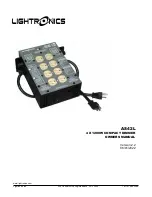
2
ENGLISH
Do not, under any circumstance, use any attachment
or accessory on this product which was not provided
with the product or identified as appropriate for use
with this product in the Operator's Manual.
Avoid dangerous environments. Do not use the
attachment in damp or wet locations. Do not use in
the rain.
Use the right attachment. Do not use for any job other
than that for which it was intended.
SPECIFIC SAFETY RULES
Never operate the product without the safety guard in
place and in good condition.
Keep the working area free from wires, nails, metallic
cable, glass, stones and debris.
Do not cut against hard objects, this could cause injury
or damage the trimmer.
Do not cross roads or gravel paths with the trimmer
still running.
As the equipment user, you are responsible for third
parties in the working area.
While operating the tool, always hold it firmly with both
hands by the two handles and ensure a firm footing,
especially if steps or ladders are used. Don’t touch the
blades!
Make sure you hold the tool firmly by both handles
and that you are well balanced with your weight evenly
distributed on both feet.
Keep hands away from cutting area and blades. Do
not reach underneath, around or over the blade while
the tool is operating. Do not attempt to remove cut
material when the blade is moving.
It has been reported that vibrations from hand-held
tools may contribute to a condition called Raynaud’s
Syndrome in certain individuals. Symptoms may
include tingling, numbness and blanching of the
fingers, usually apparent upon exposure to cold.
Hereditary factors, exposure to cold and dampness,
diet, smoking and work practices are all thought to
contribute to the development of these symptoms.
There are measures that can be taken by the operator
to possibly reduce the effects of vibration:
a) Keep your body warm in cold weather. When
operating the unit wear gloves to keep the hands
and wrists warm. It is reported that cold weather is a
major factor contributing to Raynaud’s Syndrome.
b) After each period of operation, exercise to increase
blood circulation.
c) Take frequent work breaks. Limit the amount
of exposure per day. If you experience any of the
symptoms of this condition, immediately discontinue
use and see your doctor.
CAUTION:
Certain parts of the machine may become hot
during use.
■
Familiarise yourself with your surroundings and be
on the alert for possible hazards which you may not
notice because of the noise from the machine.
■
Never grasp the tool by the blade.
■
Large variations in temperature can lead to
condensation inside the tool. Before use, give the
machine time to adjust to the temperature of the work
area.
■
Do not force the tool. It will do the job better and with
less likelihood of a risk of injury at the rate for which it
was designed.
■
Never attempt to use an incomplete machine or one
fitted with an unauthorised modification.
■
When transporting, disconnect the spark plug wire.
■
During transport or storage always cover the with the
cover.
■
Do not operate the machine with a damaged or
excessively worn cutting device.
■
To reduce fire hazard keep engine and silencer free
of debris, leaves, or excessive lubricant.
■
Always ensure all handles are fitted when using the
machine.
■
Know how to stop the machine quickly in an
emergency.
■ Please refer to the manual of your power head for
information on:
1. Instructions of how to set the carburetor and ignition.
2. instructions giving detailed explanations of all
controls.
FUEL AND REFUELING
HANDLING THE FUEL SAFELY
■ Do not smoke when mixing fuel or filling fuel tank.
Inspect the unit before each use for loose fasteners,
fuel leaks, etc.
■ Replace any damaged parts before use. Mix and
store fuel in a container approved for fuel.
■
Mix fuel outdoors where there are no sparks or
flames. Wipe up any fuel spillage. Move 9m away
from refuelling site before starting engine.
■
Stop the engine and allow to cool before refuelling or
storing the unit.
■
Allow the engine to cool; empty the fuel tank and
secure the unit from moving before transporting in a
vehicle.
■
Always handle fuel with care, it is highly flammable.
■
Always refuel outdoors where there are no sparks
and flames. Do not inhale fuel vapours.
■
Do not let petrol or oil come in contact with your skin.



























